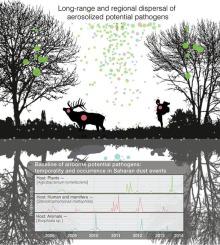Environment International ( IF 10.3 ) Pub Date : 2021-10-06 , DOI: 10.1016/j.envint.2021.106916 Xavier Triadó-Margarit 1 , Joan Cáliz 1 , Emilio O Casamayor 1

|
The atmosphere is a potential pathway for global-scale and long-range dispersal of viable microorganisms, promoting biological interconnections among the total environment. We aimed to provide relevant baseline information for long-range long-term intercontinental exchange of potentially infectious airborne microorganisms of major interest in environmental and health-related disciplines. We used an interannual survey (7-y) with wet depositions fortnightly collected above the boundary layer (free troposphere) at a remote high-elevation LTER (Long-Term-Ecological-Research) site, analyzed by 16S and 18S rRNA genes, and compared to a database of 475 well-known pathogens. We applied a conservative approach on close relatives of pathogenic species (>98% identity) standing their theoretical upper limit for atmospheric baseline relative abundances. We identified c. 2–3% of the total airborne microbiota as potential pathogens. Their most frequent environmental origins were soil, aquatic, and anthropogenic sources. Phytopathogens (mostly fungi) were the potential infectious agents most widely present. We uncovered consistent interannual dynamics with taxa foreseeable over time (i.e., predictable seasonal behavior) and under recurrent environmental scenarios (e.g., Saharan dust intrusions), respectively, being highly valuable microbial forensic environmental indicators. Up to 8 bacterial and 21 fungal genera consistently showed temporal abundances and recurrences unevenly distributed. Incidence of allergenic fungi was lower in summer, and significantly higher in spring. Close relatives to Coccidioides posadasii consistently showed higher signals (i.e., high specificity and high fidelity) in winter, whereas Cryptococcus neoformans had a significant signal in spring. Along Saharan dust intrusions, the bacterial phytopathogens Acidovorax avenae and Agrobacterium tumefaciens and the fungal phytopathogens Pseudozyma hubeiensis and Peniophora sp. consistently showed higher signals. Potential human pathogens showed low proportion, being mostly fungal allergens. Microorganisms related to obligated human, amphibian and fish pathogens were commonly found in winter. More studies in remote field sites above the boundary layer will unveil whether or not a similar trend is found globally.
中文翻译:

空气传播病原体洲际交换的长期大气基线
大气是活微生物在全球范围内和远距离扩散的潜在途径,促进了整个环境之间的生物相互联系。我们旨在为环境和健康相关学科的潜在传染性空气传播微生物的远程长期洲际交换提供相关基线信息。我们使用了一项年际调查(7 年),在一个偏远的高海拔 LTER(长期生态研究)站点的边界层(自由对流层)上方每两周收集一次湿沉积物,通过 16S 和 18S rRNA 基因进行分析,以及与 475 种知名病原体的数据库相比。我们对致病物种的近亲(> 98%同一性)采用保守方法,站在大气基线相对丰度的理论上限。我们确定了 c。空气中总微生物群的 2-3% 是潜在的病原体。它们最常见的环境来源是土壤、水生和人为来源。植物病原体(主要是真菌)是最广泛存在的潜在感染因子。我们发现了随着时间的推移(即可预测的季节性行为)和反复出现的环境情景(例如,撒哈拉沙尘入侵)下可预见的分类群的一致的年际动态,分别是非常有价值的微生物法医环境指标。多达 8 个细菌属和 21 个真菌属始终显示出时间丰度和不均匀分布的复发。夏季致敏真菌发生率较低,春季显着升高。近亲 它们最常见的环境来源是土壤、水生和人为来源。植物病原体(主要是真菌)是最广泛存在的潜在感染因子。我们发现了随着时间的推移(即可预测的季节性行为)和反复出现的环境情景(例如,撒哈拉沙尘入侵)下可预见的分类群的一致的年际动态,分别是非常有价值的微生物法医环境指标。多达 8 个细菌属和 21 个真菌属始终显示出时间丰度和不均匀分布的复发。夏季致敏真菌发生率较低,春季显着升高。近亲 它们最常见的环境来源是土壤、水生和人为来源。植物病原体(主要是真菌)是最广泛存在的潜在感染因子。我们发现了随着时间的推移(即可预测的季节性行为)和反复出现的环境情景(例如,撒哈拉沙尘入侵)下可预见的分类群的一致的年际动态,分别是非常有价值的微生物法医环境指标。多达 8 个细菌属和 21 个真菌属始终显示出时间丰度和不均匀分布的复发。夏季致敏真菌发生率较低,春季显着升高。近亲 我们发现了随着时间的推移(即可预测的季节性行为)和反复出现的环境情景(例如,撒哈拉沙尘入侵)下可预见的分类群的一致的年际动态,分别是非常有价值的微生物法医环境指标。多达 8 个细菌属和 21 个真菌属始终显示出时间丰度和不均匀分布的复发。夏季致敏真菌发生率较低,春季显着升高。近亲 我们发现了随着时间的推移(即可预测的季节性行为)和反复出现的环境情景(例如,撒哈拉沙尘入侵)下可预见的分类群的一致的年际动态,分别是非常有价值的微生物法医环境指标。多达 8 个细菌属和 21 个真菌属始终显示出时间丰度和不均匀分布的复发。夏季致敏真菌发生率较低,春季显着升高。近亲 夏季致敏真菌发生率较低,春季显着升高。近亲 夏季致敏真菌发生率较低,春季显着升高。近亲Coccidioides posadasii在冬季始终表现出较高的信号(即高特异性和高保真度),而新型隐球菌在春季具有显着的信号。沿着撒哈拉沙尘入侵,细菌植物病原体Acidovorax avenae和农杆菌以及真菌植物病原体Pseudozyma hubeiensis和Peniophora sp。一直表现出更高的信号。潜在的人类病原体比例较低,主要是真菌过敏原。与义务人类、两栖动物和鱼类病原体相关的微生物在冬季很常见。在边界层以上的偏远现场进行的更多研究将揭示是否在全球范围内发现了类似的趋势。











































 京公网安备 11010802027423号
京公网安备 11010802027423号